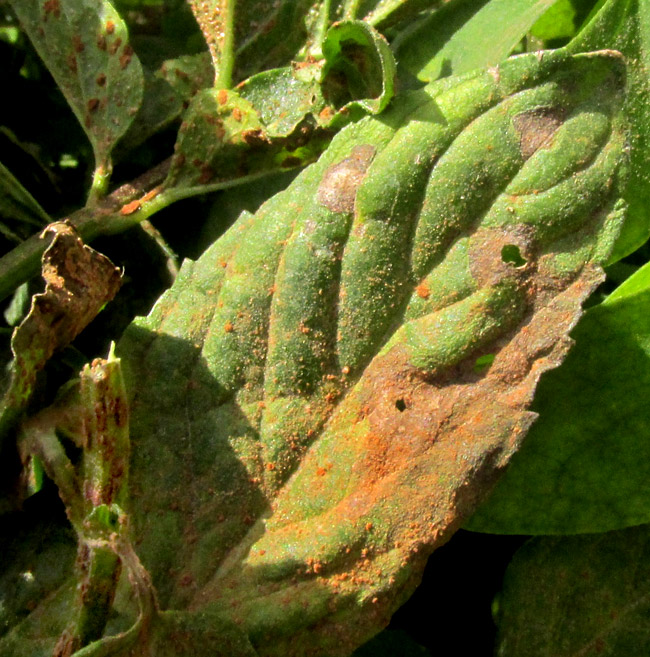Excerpts from Jim Conrad's
Naturalist Newsletter
Entry dated January 14, 2024, issued from near Tequisquiapan; elevation about 1,900m, (6200 ft), ~N20.57°, ~W99.89°; Querétaro state, MÉXICO
MINT RUST

During the current drought I water the Peppermint, Mentha x piperita, each day, and now I see that I should have made more effort to avoid wetting the leaves -- pour the water directly onto the ground. For, above you see that the sprouts, seemingly overnight, have become heavily infected with the fungal disease known as Mint Rust, PUCCINIA MENTHAE.

The disease currently manifests mainly as pimple-like pustules on the leaves' undersurfaces. In areas with cold winters, when autumn cools to a certain point, infected mint leaves turn deep-chocolate brown. On my plants, so far just one leaf is showing this, seen below:

So far this year here in the highlands of central Mexico we have experienced no frosts, and there may be none the whole season. I'm find no information on how the disease affects plants under our temperate, possibly no-frost conditions. Using literature available on the Internet to work out the life cycle can be confusing because different terms for the same thing may be used, plus the plant behaves differently under different seasonal conditions. The life cycle as described on the current Wikipedia page for the disease is hard to follow and incomplete.
However, various sources do describe Puccinia menthae as an autoecious macrocylclic rust. "Autoecious" indicates that the species completes its entire life cycle on a single species, in our case on Peppermint plants. The term "macrocylclic" when applied to rust fungi explains that during its life cycle five spore phases are expressed. Worked out from a variety of sources, here's my simplified general life cycle for the disease on Peppermint plants not growing here in central Mexico, but rather where freezes occur:
However, urediniospores can't survive cold temperatures. At a certain point when the weather is cooling down, urediniospore infection, instead of producing new uredia as during warm weather, produce yet another kind of pustule, known as telia. And telia produce the overwintering teliospores with which we began this life cycle.
Not only that, but various "strains" of Puccinia menthae have been documented, and each strain has its own preference of host or hosts. For example, in the 2016 "Report on Plant Disease, Mint Rust," issued by the Univeristy of Illinois Extention, it was said that a Puccinia menthae isolate produced from Oregano could infect other Oregano plants, as well as Greek Oregano and Sweet Marjoram, but could not infect Spearmint; all these species are members of the Mint Family.
Not all rust species develop through the above five spore phases all taking place on the same species. For example, Cedar-Apple Rust spends 18-20 months on cedar trees, then other kinds of spores are produced during four to six months on apple trees. Cone Rust takes two to three years of pine cone infection before spores are produced. Also, the prime host is a pine tree, but the fungus's entire life cycle requires time spent on an oak, during the teliospore phase.
Why do rust species bother with all these different spore phases? One can see the advantage of have overwintering teliospores, and urediniospores which can be reproduced in several fast-developing and self-reproducing warm seasons, but why the rest? From what I can see, there's no clear answer. In the 2018 study by Cécile Lorrain and others entitled "Advances in understanding obligate biotrophy in rust fungi," a whole subdivision has the title "The different facets of rust life cycles and unresolved questions about their evolution." "Unresolved" appears to be the current status of our question.
Whatever the reason, my Peppermint plant's disease has been a pleasure to learn about. Knowing what I now know about Mint Rust, it appears that either I need to get used to having diseased Peppermint, or else just compost the whole plant and not put out any more Peppermint in this area.